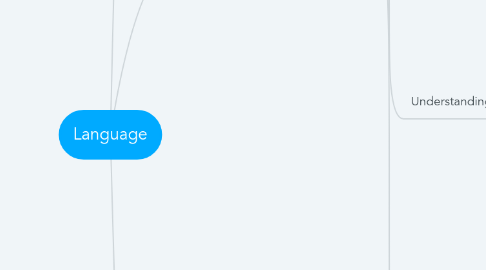
1. Language
1.1. Properties of Language
1.1.1. Communicative
1.1.2. Arbitrarily symbolic
1.1.2.1. Principle of conventionality
1.1.2.2. Principle of contrast
1.1.3. Regularly structured
1.1.4. Structured at multiple levels
1.1.5. Generative, productive
1.1.6. Dynamic
1.2. Basic Components of Words
1.2.1. Phoneme
1.2.2. Morpheme
1.2.2.1. Content Morpheme
1.2.2.2. Functional Morpheme
1.2.3. Lexicon
1.3. Basic Components of Sentences
1.3.1. Syntax
1.3.2. Noun Phrase
1.3.3. Verb Phrase
1.4. Understanding the Meaning of Words, Sentences, and Larger Text Units
1.4.1. Semantics
2. Language Comprehension
2.1. Understanding Words
2.1.1. Problems when trying to understand what someone else is sayong
2.1.1.1. Foreign languages and unfamiliar sounds are difficult to grasp.
2.1.1.2. Variability across pronunciation
2.1.1.3. Coarticulation
2.1.1.4. Speech segmentation
2.1.2. The View of Speech Perception as Ordinary
2.1.2.1. Template-matching or feature-detection processes
2.1.2.1.1. Phonetic refinement theory
2.1.2.2. TRACE model
2.1.2.2.1. Phonemic-restoration effect
2.1.3. The View of Speech Perception as Special
2.1.3.1. Categorical Perception
2.1.3.2. Motor Theory of Speech Perception
2.1.3.2.1. McGurk effect
2.2. Understanding Meaning
2.2.1. Words as symbols for concepts
2.2.1.1. ease of understanding and remembering a text passage.
2.2.1.2. it enhances subjects’ recall of the shape of a droodle.
2.2.1.3. affects the accuracy of eyewitness testimony.
2.2.2. Meanings of words
2.2.2.1. can be
2.2.2.1.1. **Denotation**—strict dictionary definition of a word **Connotation**—word’s emotional overtones, presuppositions, and other non explicit meanings
2.2.2.1.2. **Dominant MEANING** - used more often **Subordinate MEANING** - can be more than one
2.2.2.2. are retrieved depending on their defining features.
2.2.2.2.1. **Organic objects/Living things**
2.2.2.2.2. **Man-made objects/tools**
2.3. Understanding Sentences
2.3.1. Syntax
2.3.1.1. Impacts of Syntax
2.3.1.1.1. Syntactical Priming
2.3.1.1.2. Speech Errors
2.3.1.1.3. Parsing
2.3.2. Grammar
2.3.2.1. Prescriptive grammar
2.3.2.2. Descriptive grammar
2.3.3. Phrase-structure grammar
2.3.3.1. Tree diagrams
2.3.4. Transformational grammar
2.3.4.1. Deep Structure
2.3.4.2. Surface Structure
2.4. Relationships between Syntactical and Lexical Structures
2.4.1. Lexical items also contains **syntactical information.**
2.4.1.1. the syntactical category of the item
2.4.1.2. the appropriate syntactical contexts in which the particular morpheme may be used
2.4.1.3. any idiosyncratic/specific information about the syntactical uses of the morpheme
2.4.2. Linking **mental lexicon elements** with **syntactictal structures**
2.4.2.1. Lexical items
2.4.2.1.1. Thematic roles
3. Reading
3.1. Dyslexia
3.1.1. Phonological awareness
3.1.1.1. Phoneme-deletion task
3.1.1.2. Phoneme counting
3.1.2. Phonological reading
3.1.3. Phonological coding in working memory
3.1.4. Lexical access
3.2. Types of Dyslexia
3.2.1. Developmental dyslexia
3.2.2. Acquired dyslexia
3.3. 3 Processes that Contribute to our Ability to Read
3.3.1. Perceptual processes
3.3.1.1. Orthographic
3.3.1.2. Phonological code
3.3.2. Lexical processes
3.3.2.1. Fixations and Reading Speed
3.3.2.1.1. Saccades
3.3.2.1.2. Sentence wrap-up time
3.3.2.2. Lexical Access
3.3.2.2.1. Interactive-activation model
3.3.2.2.2. Word-superiority effect
3.3.2.2.3. Sentence-superiority effect
3.3.2.3. Intelligence and Lexical-Access Speed
3.3.3. Comprehension processes
3.3.3.1. Comprehending Known Words: Retrieving Word Meaning from Memory
3.3.3.1.1. Semantic encoding
3.3.3.2. Comprehending Unknown Words: Deriving Word Meanings from Context
3.3.3.2.1. Learning from context
3.3.3.3. Comprehending Ideas: Propositional Representations
3.3.3.3.1. Model of text comprehension
3.3.3.3.2. Proposition
3.3.3.3.3. Macropropositions
3.3.3.4. Comprehending Text Based on Context and Point of View
3.3.3.4.1. Passage of text often depends on our point of view
3.3.3.5. Representing the Text in Mental Models
3.3.3.5.1. Mental model
3.3.3.5.2. Bridging inference
